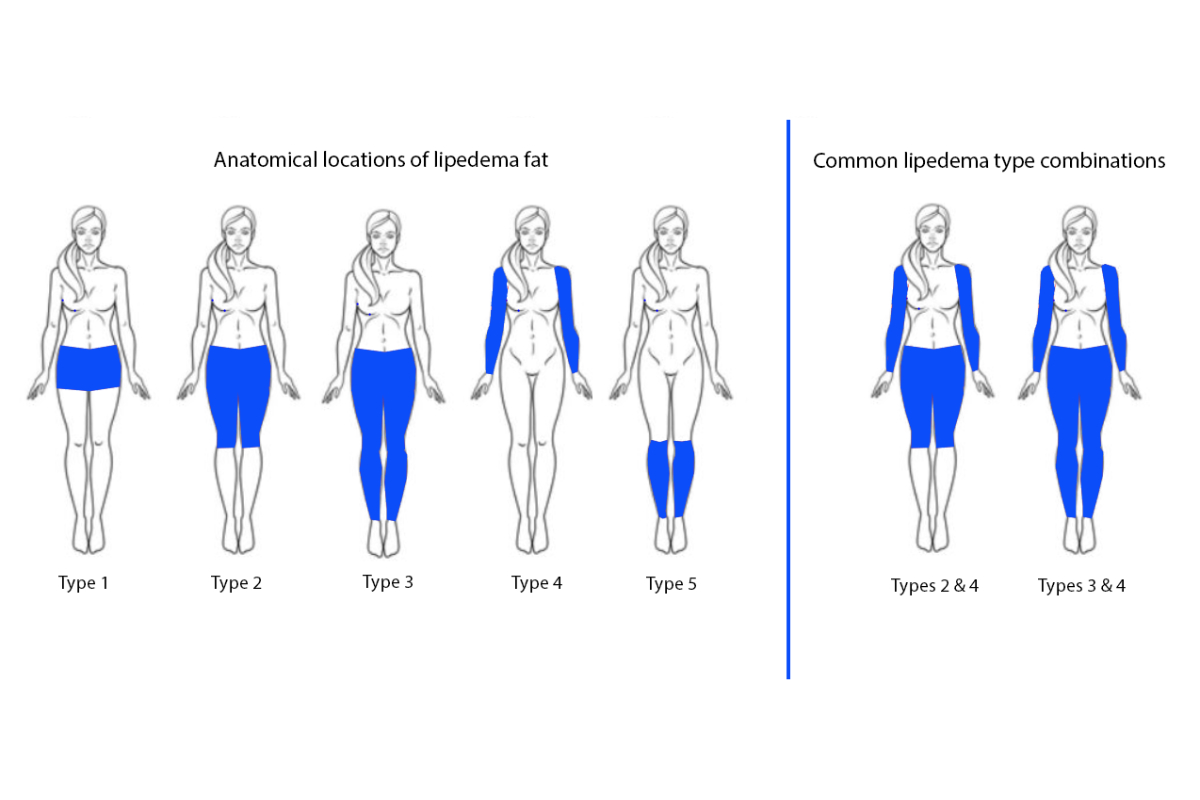Lipedema – Causes and Solutions
Avinav
January 20, 2023
According to estimates, lipedema affects 10% of women worldwide. Both the general public and Indian medical professionals are not sufficiently informed. India’s incidence has not yet been determined. The extremities are the main areas affected by lipedema, which tends to affect the lower limbs more so than the upper limbs. Under the skin, there is an aberrant fat deposition that starts out smooth and eventually turns granular or nodular. The fat may become sore and painful as the condition worsens. Thus, this condition is also known as “painful fat syndrome”. The discomfort may be bothersome and annoying and may worsen.
Mobility is impacted, exercise becomes difficult, and eventually one begins to put on weight in regions that would otherwise be normal. This could have the unintended side effect of obesity, which is related to lipedema. Due to the relative ignorance about lipedema in the medical world, the majority of primary physicians either write off the condition as lymphedema or general obesity, ignore it, or prescribe diet and exercise as a treatment, occasionally together with significant and invasive weight loss surgery. The affected person’s physical and mental health suffers as a result of the disease’s progression, whether as a result of unintentional advice or oversight or willful self-neglect.
Detecting Lipedema
In rare instances, lipedema can be identified by a straightforward comparison of the top and bottom halves: the lower body is disproportionately larger than the upper body (the typical pear shape). Some of the following symptoms may be present in those who have it:
- Wider hips, thighs, legs, or arms than the waist.
- Difficulty in finding proper fitting garments or dresses of their size due to disproportionate body shape
- Easy bruising may be noticed in the affected areas.
- Fat limiting at the ankles and wrists gives an appearance of bands or cuffs.
- Varying degrees of pain to touch or pressure due to which decreased mobility is experienced.
- Developing secondary obesity.
Stages of Lipedema
Stage 1: The skin is smooth and contains a greater proportion of smooth subcutaneous fat.
Stage 2: Cellulite-appearing skin becomes wavy and uneven, and the underlying fat is granular or nodular.
Stage 3: In this stage, the skin becomes wavy and has folds that hang over the skin, along with aberrant deposits that are most noticeable around the knees and across the shin of the leg.
Stage 4: Advances past the aforementioned stages (affecting the buttocks, thighs, and legs), with or without lymphedema symptoms.
Why does the body develop Lipedema?

Adipocytes, which specialise in fat storage, are present in the tissues under the skin. These adipocytes hypertrophy as they store fat and grow in size. These adipocyte cells also start to multiply at the same moment, a process known as hyperplasia. The growth of the fat is atypical due to the interaction of hypertrophy and hyperplasia. Since the capillaries do not develop proportionately, they stretch and break easily, which leads to bruising. The tissues’ sensitivity may also be caused by the nerve fibres being stretched. As time passes, the cells continue to multiply and increase, limiting the blood flow and depriving the tissues of enough nutrients and oxygen. This inflames the starved nerves, irritating them and resulting in pain that cannot be explained. The accumulation of tissues lead to increasingly pronounced abnormalities and malformations.
The normal appearance may be as follows:-
- Modest to substantial nodular fat growths
- Unusual fat buildup in the troubled areas
- Forced leg spread and unusual gait pattern brought on by uncomfortable fat deposits in the inner and upper thighs
- Lessening of movement
- Depression and irritability brought on by discomfort and pain
- Strange fat pads on top of and below the knees
Even though we are aware of everything, we are still hunting for answers. First off all it’s still unclear what causes lipedema exactly. Secondly as the World Health Organization only recently began to recognise this disorder, the symptoms are typically attributed to general obesity. As a result, both the general public and healthcare professionals lacked awareness. More than half of documented cases—though not all—show some evidence of a familial history and an early beginning of symptoms during puberty. It has been discovered to advance or begin during pregnancy or menopause. According to studies, lipedema fat is surprisingly not insulin resistant like normal fat, which results in a decreased incidence of type 2 diabetes in its early stages or up until obesity joins the fray.
Options for Treatment
The treatment has been divided into non-surgical and surgical approaches by a variety of experts taking into account what is currently known. In all categories, the goal is to lessen discomfort, bruising, swelling, and severity of spider and varicose veins as well as their side effects. It also aims to minimize fat volume, avoid infections, and stop further advancement. The short term results of diet and exercise have been sporadic. The only way to remove built-up lipedema fat and stop or slow the disease’s progression at the moment is through liposuction surgery while safeguarding the lymphatic architecture using a water-assisted or tumescent technique. Additionally favorable factors are diet, exercise, and lymphatic massages/pump. Exercise and diet yo-yos have been shown to exacerbate lipedema, especially if someone is obese. The key to long-term happiness is an early diagnosis and a methodical, scientific treatment.
Non-Surgical Alternatives
Early on, it is crucial to instil in each patient the knowledge that “Weight increase is not an option in lipedema.” Healthy behaviours, including advice on diet and exercise, are crucial.
The secret to better lymphatic system circulation is to wear tight compression clothing round-the-clock, seven days a week. The disease’s stage and the nature of the affected areas determine the compression’s strength.
The lymphatic system can also be stimulated by using a mild skin massage, often known as Manual Lymph Drainage (MLD). Despite being in doubt, this method’s advantages do have an impact.
A diet limited in carbohydrates and sweets has been found to have a positive effect on lowering the inflammatory component and progression of lipedema.
Walking, cycling, yoga, water aerobics, and swimming are all low-impact activities that have been reported to help people maintain their weight.
Surgical Procedures Available

If weight gain persists despite non-surgical attempts, surgery should be considered to slow or stop the development of the abnormal fat deposition.
The lipedema fat can be targeted and removed via tumescent liposuction or water assisted liposuction (bodyjet). The already fragile lymphatic system needs to be protected. After surgery, liquid drainage from the lower ports normally stops in a day or two, though it occasionally lasts longer when significant amounts of fluid are removed. Because they have the potential to harm lymphatic vessels, conventional liposuction methods, lasers, ultrasound, and radiofrequency techniques should be avoided. The lymphatic system is protected from harm by the water assisted liposuction. In general, it is best to deal with the most uncomfortable or painful areas first before moving on to less severe ones.
Care and Healing following surgery:-
Drainage from wound sites often lasts one to four days. Incisions shut and recover in one to two weeks. Within a few hours of surgery, early low-impact exercises are encouraged. For ten to two weeks, excessive pressure on the operated site should be avoided.
After surgery, swelling lasts for 4-6 weeks, during which time compression clothing must be worn. It has been discovered that an occasional MLD/sequential lymphatic pump is beneficial for lymphatic circulation.
In the majority of cases, patients report increased mobility, reduced discomfort, sensitivity, and bruising along with an improvement in their quality of life. After surgery, there is a significantly reduced need for non-surgical techniques and they are largely symptom-free.
Why choose for Liposuction with Water Assistance?
The main reasons why non-surgical techniques are preferred over surgical ones are cost convenience and dread of the procedure. Non-surgical techniques also seem to be more readily available and less expensive. Non-surgical treatments only partially and transiently improve the situation, which makes people weaker and more distressed as the illness worsens.
The permanent removal of lipedema fat from the operated area reduces pain and other symptoms and improves the person’s overall shape while delaying or arresting the progression of the disease and reversing the stage of the disease for a prolonged period of time, resulting in a better and higher quality of life. Surgical options appear to be more aggressive with a limited downtime.
The Upcoming:-
Since the first worldwide meeting for consensus on lipedema from few years ago, research has been ongoing. Lipedema Fat is distinct from Conventional Fat, according to research, and it stands to reason that the Stem Cells that accompany it are likewise unique. To effectively treat Lipedema, advancements are being made. The single most efficient and long-lasting treatment for Lipedema patients at this time is Lymph Sparing Water Aided or Tumescent Liposuction.
https://www.ncbi.nlm.nih.gov/pubmed/31356433
Have Any Question?
Lipedema is a condition that causes excess fat to accumulate in the lower part of the body.
- +919515106591
- srinageshlipedema@gmail.com



